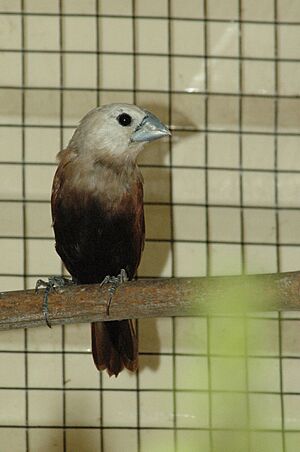White-headed munia facts for kids
Quick facts for kids White-headed munia |
|
|---|---|
 |
|
| Conservation status | |
| Scientific classification | |
| Genus: |
Lonchura
|
| Species: |
maja
|
| Synonyms | |
|
Loxia maja Linnaeus, 1766 |
|
The white-headed munia (Lonchura maja) is a small, pretty bird. It's a type of estrildid finch, which means it's part of a family of small, seed-eating birds. You can find these birds in places like Malaysia, Singapore, Thailand, and Vietnam. They also live in Teladan and have even been introduced to Portugal. White-headed munias love to live in wetlands, which are areas like marshes and swamps. Good news! Scientists say this bird is a "Least Concern" species, meaning it's not currently in danger of disappearing.
Contents
About Its Name
Scientists give every living thing a special name, like a first and last name, so everyone knows exactly which creature they are talking about. The white-headed munia got its official scientific name, Loxia maja, in 1766 from a Swedish scientist named Carl Linnaeus. Later, it was moved into a group of birds called Lonchura. This bird doesn't have any different types or subspecies.
What It Looks Like
The white-headed munia is a small bird, about 11 centimeters (about 4.3 inches) long. It has a white head and a brown body. It looks a bit like the chestnut munia, but the white-headed munia is a lighter brown. Its whole head and throat are white, which makes it easy to spot!
Young white-headed munias look a bit different. Their upper parts are brown, and their faces and undersides are a light, creamy brown color called buff. Their eyes are brown, their beaks are grey, and their feet are a pale blue. When they make a sound, it's a high-pitched 'pee-pee' call.
Where It Lives and Its Status
You can find white-headed munias in the Malay Peninsula, Sumatra, Java, Bali, and Celebes. In Java and Bali, they are quite common and live in many places, even up to 1500 meters (about 4900 feet) high.
As mentioned, this bird is listed as "Least Concern." This means that even though they live in specific areas, there are still plenty of them around, and they are not currently at risk of becoming endangered.
How It Behaves
White-headed munias often hang out in marshes and areas with lots of reeds. Like other munias, they form big groups or flocks when farmers are harvesting rice. This helps them find food easily. But when it's time to have babies, they spread out and form pairs. Their general behavior is similar to other birds in the munia family.
What It Eats
These birds mainly eat seeds. Their favorite foods include rice and different kinds of grass seeds.
Reproduction
When it's time to lay eggs, white-headed munias usually lay four to five white eggs. Sometimes, they might lay six. They build a special nest that looks like a ball, made out of grass. In West Java, people have seen them breeding in February.


